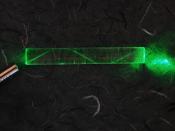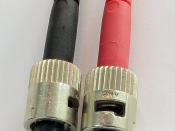Optical Fibers are glass fibers usually about 120 micrometers in diameter that are used to deliver wave signals in the form of pulses of light over distances up to 50 km without the using repeaters. These wave signals may be coded voice communications or computer data.
Fiber optic communications is dependent on the principle that light in a glass medium can carry more information over longer distances than electrical signals can carry in a copper or coaxial medium. The purity of today's glass fiber mixed with advance electronics system allows fiber to transmit digitized light signals well beyond 100 km without amplification. Optical fiber is an ideal transmission medium with few transmission losses, low interference and high bandwidth potential.
How Fiber Works
The working of an optical fiber is dependent on the principle of total internal reflection. Light reflects or refracts based on the angle at which it strikes a surface.
This principle is at the center of how optical fiber works. Restricting the angle at which the light waves are delivered makes it possible to control how efficiently they reach their destination. Light waves are covered with the core of the optical fiber in much the same way that radio frequency signals are covered with coaxial cable. The light waves are directed to the other end of the fiber by being reflected within the core.
The creation of the cladding glass relative to the core glass decides the fiber's capability to reflect light. That reflection is usually occurred by creating a higher refractive index in the core of the glass than in the surrounding cladding glass creating a "waveguide". The refractive index of the core is improved by slightly changing the composition of the core glass generally by adding small amounts of a dopant. Alternatively the waveguide can be...


